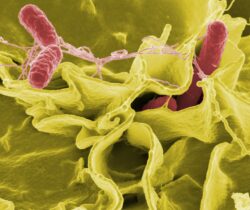Rare Childhood Cancer Spreads Rapidly: New Hope in Targeted Therapy
Childhood Midline Tract Carcinoma, a rapidly spreading rare cancer, primarily impacts children and young adults. This article explores its causes, diagnosis, and current treatments. It delves into the promising field of targeted therapy, which could offer more precise treatment with fewer side effects. It highlights ongoing clinical trials and the potential for revolutionizing the treatment of this aggressive disease. Understanding this disease and its innovative treatments is crucial for improving patient outcomes.

Key Takeaways
- Childhood midline tract carcinoma is a rare and aggressive type of cancer that commonly affects children and young adults.
- Midline tract carcinoma is caused by a change in the NUT gene, which leads to the formation of malignant cells.
- Diagnostic tests such as physical exams, medical history reviews, imaging scans, and biopsies are used to identify midline tract carcinoma.
- Treatment options for childhood midline tract carcinoma include surgery, radiation therapy, chemotherapy, and targeted therapy, which is being tested in clinical trials.
Understanding Childhood Midline Tract Carcinoma
The childhood midline tract carcinoma, an aggressive and rare type of cancer that primarily affects children and young adults, is characterized by the rapid formation and spread of malignant cells in the respiratory tract or other areas along the middle of the body. Childhood cancer research has played a pivotal role in understanding the genesis and progression of this disease. Through extensive study, researchers have uncovered a unique genetic alteration that drives the development of this cancer. Advances in treatment offer a glimmer of hope to affected families. While traditional treatments like surgery, radiation, and chemotherapy remain mainstays, targeted therapy, a novel treatment approach that precisely attacks cancer cells, is promising. Continuous research and clinical trials are vital to improving survival rates and finding a cure.
Identifying The Locations of Midline Carcinoma
Mapping the locations of midline carcinoma involves meticulous examination of the patient's body, and it plays a crucial role in diagnosing this rapidly spreading childhood cancer. Detection methods for midline tract carcinoma include physical examinations, medical history reviews, and advanced imaging techniques like MRI and CT scans. Biopsies, immunohistochemistry and cytogenetic analysis are also employed to confirm the diagnosis. These methods help identify the exact location of the carcinoma, aiding in staging the disease and planning treatment. Recent advances in targeted therapy for midline tract carcinoma offer renewed hope. These therapies, designed to attack specific cancer cells, reduce harm to normal cells. Clinical trials are exploring these therapies, potentially paving the way for more effective, personalized treatment strategies for this aggressive cancer.
Unveiling the Causes of Midline Tract Carcinoma
In our pursuit to understand midline tract carcinoma, we must delve into the causes behind this aggressive form of childhood cancer. Understanding genetic mutations is crucial in this process. This rare cancer is primarily due to a specific rearrangement involving the NUT gene, leading to uncontrolled cell growth. This genetic alteration is not hereditary but occurs spontaneously in body cells. Advances in immunohistochemistry have enriched our comprehension of this disease. This technique enables the detection of the NUT gene mutation in tumor tissue samples, providing a definitive diagnosis of midline tract carcinoma. These developments continue to contribute significantly to our understanding of this disease, facilitating the development of targeted therapeutic strategies.
Diagnostic Measures for Detecting Midline Tract Carcinoma
Effective diagnostic measures for midline tract carcinoma encompass a range of laboratory tests, imaging procedures, and biopsy evaluations, forming a comprehensive disease detection protocol. Diagnostic advancements have greatly enhanced our ability to detect this rare cancer at an early stage. These include innovative imaging techniques such as MRI and CT scans, and sophisticated laboratory tests like immunohistochemistry and cytogenetic analysis. Biopsies, often guided by advanced imaging, allow for accurate identification of malignant cells. Early detection is crucial for effective treatment and improved prognosis, underscoring the importance of these diagnostic measures. Furthermore, genetic testing can identify changes in the NUT gene, a hallmark of midline tract carcinoma. Combined, these measures provide a robust and effective strategy for diagnosing this aggressive childhood cancer.
An Overview of Current Treatment Methods
With the progression of medical science, several treatment methods have emerged for dealing with the aggressive nature of childhood midline tract carcinoma. Traditional methodologies primarily involve surgery, radiation therapy, and chemotherapy. However, these approaches often come with substantial potential side effects. Consequently, medical professionals are exploring alternative treatments. Emphasis has been placed on targeted therapy, which uses substances to precisely identify and attack cancer cells, sparing healthy cells and reducing side effects. Furthermore, clinical trials are being conducted to test new drugs, providing hope for more effective treatment strategies. Despite the rapid spread of this rare cancer, these advancements suggest a promising future in combating childhood midline tract carcinoma.
The Role of Targeted Therapy in Treatment
Targeted therapy, a promising frontier in cancer treatment, and clinical trials form the crux of new strategies in tackling rare childhood midline tract carcinoma. Advances in immunotherapy have brought new optimism, with these therapies specifically designed to boost the body's natural defenses to fight the cancer. Targeted therapy works by blocking the growth of cancer cells, interfering with cellular division or promoting programmed cell death, thereby hindering the disease's progression. However, like all treatments, targeted therapy has potential side effects. These can include changes in skin color, blood pressure issues, and fatigue, among others. Despite this, the advantages of targeted therapies, particularly their precision and potency, mark them as a beacon of hope in the battle against this aggressive childhood cancer.
Insights Into Clinical Trials for Midline Tract Carcinoma
In the quest for more effective treatments for midline tract carcinoma, clinical trials have emerged as a crucial component, and they offer a glimpse into the potential advancements in combating this aggressive form of childhood cancer. These trials are at the forefront of medical research, exploring the targeted therapy effectiveness in managing this rare and fast-spreading disease. The promising clinical trial advancements are opening new avenues in the fight against midline tract carcinoma, with targeted therapies exhibiting potential to selectively eradicate cancer cells while sparing healthy ones. As these trials progress, they not only advance our understanding of the disease but also pave the way for the development of more effective, targeted treatment strategies, offering hope for improving patient outcomes in the future.
The Potential of New Targeted Therapies
As the landscape of cancer treatment continues to evolve, so too does the potential of new targeted therapies, particularly for the treatment of rare childhood cancers like midline tract carcinoma. These therapies aim to specifically target cancer cells, minimizing damage to healthy cells and potentially reducing side effects. Emerging research is exploring how these targeted therapies can disrupt the growth and spread of cancer cells, slowing the progression of this aggressive disease. However, as with any new treatment, potential side effects must be considered and thoroughly investigated. It is essential for physicians, patients, and families to be educated about these potential risks and benefits. As we continue to advance our understanding, targeted therapies offer a beacon of hope in the fight against rare childhood cancers.
The Importance of Participation in Clinical Trials
Understanding the value of clinical trials and deciding to participate in them not only provides patients with access to potentially life-saving treatments, but also contributes significantly to the advancement of medical research in childhood cancers. The benefits of participating in clinical trials are manifold. They offer access to innovative therapies before they are widely available, contribute to the scientific understanding of the disease, and may provide the best treatment option for some patients. However, there are also risks involved, such as unforeseen side effects or ineffectiveness of the experimental treatment. Yet, the potential benefits often outweigh the risks, especially when dealing with aggressive cancers. Therefore, informed decision-making about participating in clinical trials is crucial for both patients and the broader medical community.
Monitoring and Managing Post-Treatment
Every single case of childhood midline tract carcinoma requires meticulous post-treatment monitoring and management to improve survival rates and minimize the risk of cancer recurrence. This post-treatment management involves regular check-ups to assess overall health, manage any side effects from the treatment, and to detect signs of cancer returning. The frequency of these visits typically reduce over time but are integral for long-term monitoring. Additionally, lifelong surveillance might be necessary due to the possibility of late effects of treatment. These late effects could include heart problems, secondary cancers, or cognitive issues, highlighting the importance of a comprehensive, long-term monitoring plan. Ultimately, a proactive approach in monitoring and managing post-treatment is crucial to ensuring the best possible quality of life for survivors.
The Future of Treatment for Childhood Midline Tract Carcinoma
We are standing at the cusp of a significant evolution in the treatment of childhood midline tract carcinoma, and the future holds promise for more effective and less harmful therapies. Advancements in immunohistochemistry allow for precise identification of cancer cells, thereby enabling targeted therapies to attack these cells while sparing healthy ones. This offers a more personalized treatment approach, potentially improving patient outcomes. Yet, potential side effects of targeted therapy must be considered. While these therapies are designed to be less harmful than traditional treatments, they are not without risks. As we move forward, it is crucial to continue refining these therapies, mitigating side effects, and maximizing therapeutic efficacy to provide the best possible care for children battling this aggressive disease.
Frequently Asked Questions
What Are the Potential Emotional and Psychological Impacts on a Child Diagnosed With Midline Tract Carcinoma and Their Families?
A diagnosis of midline tract carcinoma can bring significant emotional and psychological challenges for the child and their family. Fear, anxiety, and uncertainty are common responses, potentially leading to stress and depression. However, therapy benefits such as counseling can mitigate these impacts, providing emotional support and coping strategies. Additionally, survivor stories can offer hope and inspiration, reinforcing the idea that despite the difficulty of the situation, recovery and a return to a normal life is possible.
How Can Parents and Caregivers Provide Support to a Child Diagnosed With Midline Tract Carcinoma?
Parents and caregivers can support a child diagnosed with midline tract carcinoma through various therapy techniques aimed at emotional support and coping mechanisms. Engaging in art therapy, play therapy, and counseling can be beneficial. Additionally, financial planning is crucial to manage the high costs associated with cancer treatment. It's important to explore various funding options, including insurance, grants, and fundraising initiatives, to alleviate financial stress and focus on the child's well-being.
What Resources Are Available for Families Dealing With a Diagnosis of Midline Tract Carcinoma in a Child?
Resources for families dealing with a diagnosis of midline tract carcinoma in a child include financial assistance programs, which can help cover treatment costs. Genetic counseling services are also available to help families understand the genetic aspects of the disease. They can provide information about the risk of recurrence in future siblings and potential targeted therapies. Support groups and psychological counseling can also offer emotional support during this challenging time.
How Does a Diagnosis of Midline Tract Carcinoma Impact a Child’s Education and Social Development?
A diagnosis of midline tract carcinoma can significantly impact a child's education and social development. Classroom adjustments may be necessary to accommodate treatment schedules and potential side effects. These adjustments, combined with frequent absences, may affect academic progress. Additionally, the child's participation in extracurricular activities might be limited due to health restrictions, potentially impacting social interactions and development. Comprehensive support from the school, healthcare team, and family is crucial for the child's wellbeing.
What Lifestyle Changes or Adaptations Are Recommended for a Child Diagnosed With Midline Tract Carcinoma?
For a child diagnosed with midline tract carcinoma, certain lifestyle changes are recommended. Dietary adjustments are crucial to support the child's overall health and ability to tolerate treatments. A balanced diet rich in nutrients can aid recovery. Physical rehabilitation is also important to maintain strength and mobility. This could include physiotherapy or structured exercise programs. Regular consultations with healthcare professionals will ensure these adaptations are tailored to the child's unique needs.
Conclusion
In conclusion, Childhood Midline Tract Carcinoma presents significant healthcare challenges due to its aggressive nature and rapid spread. Current treatment modalities, including surgery, radiation, and chemotherapy, have limitations. However, promising research into targeted therapies offers potential for more specific, less harmful treatment options. Participation in clinical trials is vital to advancing these therapies. Improved post-treatment monitoring and management can further enhance patient outcomes. Thus, the future of managing this rare pediatric cancer lies in ongoing research and innovation.

This post has been generated by AI and was not reviewed by editors. This is Not legal advice. Please consult with an attorney.




